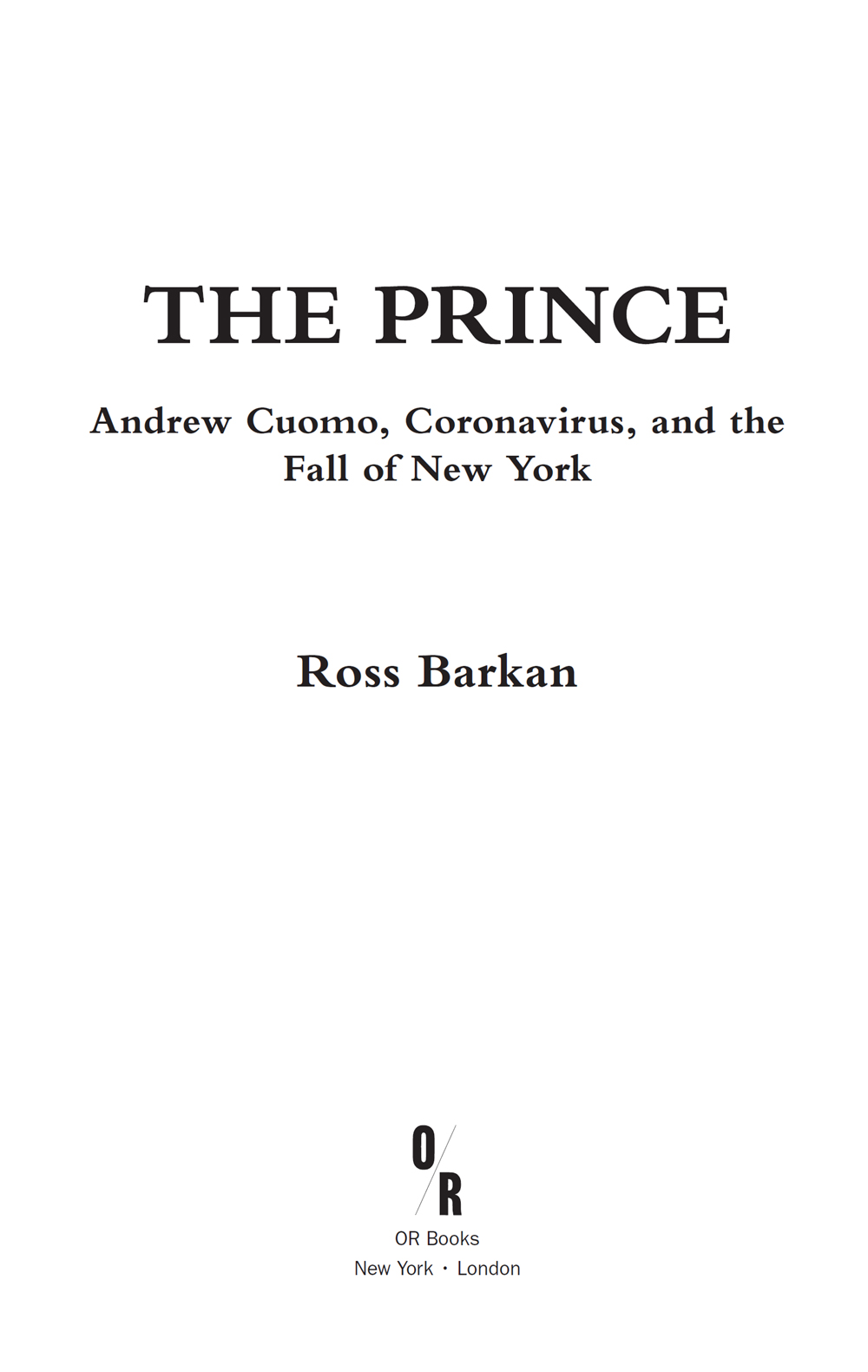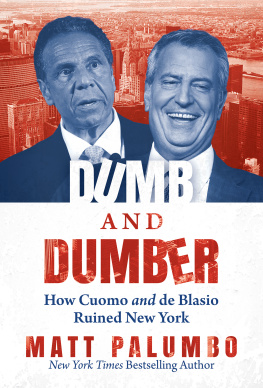



2021 Ross Barkan
Published by OR Books, New York and London
Visit our website at www.orbooks.com
All rights information:
All rights reserved. No part of this book may be reproduced or transmitted in any form or by any means, electronic or mechanical, including photocopy, recording, or any information storage retrieval system, without permission in writing from the publisher, except brief passages for review purposes.
First printing 2021
Library of Congress Cataloging-in-Publication Data: A catalog record for this book is available from the Library of Congress.
British Library Cataloging in Publication Data: A catalog record for this book is available from the British Library.
Typeset by Lapiz Digital. Printed by BookMobile, USA, and CPI, UK.
paperback ISBN 978-1-68219-410-2 ebook ISBN 978-1-68219-254-2
For Vanessa, and my mother and father
Contents
INTRODUCTION
On a warm day just before the start of summer, Governor Andrew Cuomo addressed the people of New York State and the nation for the 111th consecutive day. He was alone this time, not confining himself to a room with journalists or lecturing in front of PowerPoint slides. There were no celebrities flanking him. In a pale tie and dark suit, a photograph of his three daughters framed just to his right, Cuomo spoke with the emotion of a man who had witnessed catastrophe but conquered it completely.
Over the past three months we have done the impossible, Cuomo said. We are controlling the virus better than any state in the country and any nation in the globe. I am so incredibly proud of what we all did together and as a community. We reopened the economy and we saved livesbecause it was never a choice between one or the other. It was always right to do both.
The governor, speaking behind his desk on live television, did not take questions. He didnt have to. Among most of those watchingthe operatives, the aides, the reporters, the enormous, reverential publicthere was the feeling of a job well done, a crisis now in retreat. On that Friday, with the temperature nearing 90 degrees in the state capital of Albany, the number of people hospitalized was 1,284, compared to the more than 18,000 at the peak of the outbreak. I thought about it every day as climbing a mountain. The Mount Everest of social challenges, Cuomo said.
The address was relatively brief, clocking in at about nine minutes and fifteen seconds, and it closed with a somber yet celebratory video slideshow overlaid with narration from the governor himself. Images flashed across the screen: Cuomo, sepia-toned, with his top aide, Melissa DeRosa. Cuomo, huddled with tough men in camouflage. A whiteboard scrawled with facts about the virus. A boy removing one mask to display another mask, a message in marker combining on each: We Are All NY Tough .
Men and women appeared in masks. Others cheered from rooftops and balconies. We have the lowest rate of transmission, came Cuomos voice, the string music rising. The phased reopening is working. Stay the course.
Nowhere in the video came the death toll. This wasnt a surprise. It was a day for valedictions, for aspiration and ultimately relief. The dreaded virus was raging elsewhere. It was done, it seemed, with New York. For Cuomo, once a politician who could spend weeks without addressing a single reporter, it was a special kind of validation, the type he had been seeking in a lonely decade, from one of the nations most powerful perches.
Through all the triumphs, the failures, and the late-night rage channeled across telephone lines, Cuomo seemed to be a man cursed to govern in his fathers shadow, more feared than loved. He rarely shook hands at parades or rode the subway with the average commuter. Until 2020, he was not famous in any conventional sense, not in the currency of new media, never lodged too deeply in the consciousness of the state he had controlled since 2011.
Yet by June 19, the coronavirus briefings had drawn nearly 60 million online views, on par with the music videos of mid-level pop stars. Cuomos favorability rating had ranged as high as 77 percent.
The 111th press briefing would be the last regular daily briefing of the coronavirus pandemic, Cuomo had declared earlier that week. Though he inevitably would need to address the public again. He had set or broken a record no one knew existed, appearing day after day on the television screens of a terrified public hungry for guidance. Donald Trump, another Queens native who had once been a Cuomo donor, was incapable of providing it in the White House, where he passed the days in a fugue of rage and idiocy.
Cuomo was the contrast, hurling bare facts at his viewers and sternly comforting them, like a father huddling his brood in the London Tube during the Blitz. He spoke of his elderly mother and his loving daughters, invited up Rosie Perez and Chris Rock, unveiled a wall of colorful cloth face masks, and once took a nasal swab test for all to see.
We had all been in this together. The journalists, tasked with covering the briefings typically staged in either New York City or Albany, reflected on what they had experienced, seated with Cuomo as he became a national phenomenon. Most of those who had covered the governor for a long period of time developed newfound appreciation in this period, praising him as columnists and pundits further removed from the Albany fray had done for months on end.
Deeming it a remarkable run, the New York Times Albany bureau chief, Jesse McKinley, wrote that he thought the pleas for unity and understanding seemed genuine.
It seemed telling, too, that he quoted famous thinkersLincoln, Maya Angelouletting them lend him gravitas, McKinley continued. His own truisms he sneaked into briefings by quoting a person who didnt exist, A. J. Parkinson, an inside joke and old trick of his fathers, but also a tactic I found revealing: Here was a man who wanted to make maxims, but didnt necessarily want to be creditedor criticizedfor trying to sound profound.
The Times journalist wondered in his piece, published on June 14, if a state that had seen more than 30,000 coronavirus deathsby far the most in the United States of America, rivaling the death tolls of European nationscould claim any kind of success. But it was a question posed in the eighth paragraph, passed over quickly enough. Definitive answers wont be known for years, McKinley wrote.
But that couldnt have been farther from the truth. The reckoning came far sooner than many anticipated, with a speed and fury that shocked sclerotic Albany.
One year after the virus first appeared in New York and Cuomos press briefings made him wildly famous, the majority leader of the United States Senate, Chuck Schumer, and a vast number of New Yorks congressional delegation and state legislature were calling for Cuomo to resign. The State Assembly had launched an impeachment investigation. In the span of one calendar year, Cuomo had reached heights and depths that few politicians alive had ever known.
The genesis of his downfall was the release of a State Attorney Generals report, in early 2021, that found his Department of Health had severely undercounted nursing home deaths. Shortly after, he berated a state lawmaker who had challenged him on the issue, drawing national headlines.
Next page












